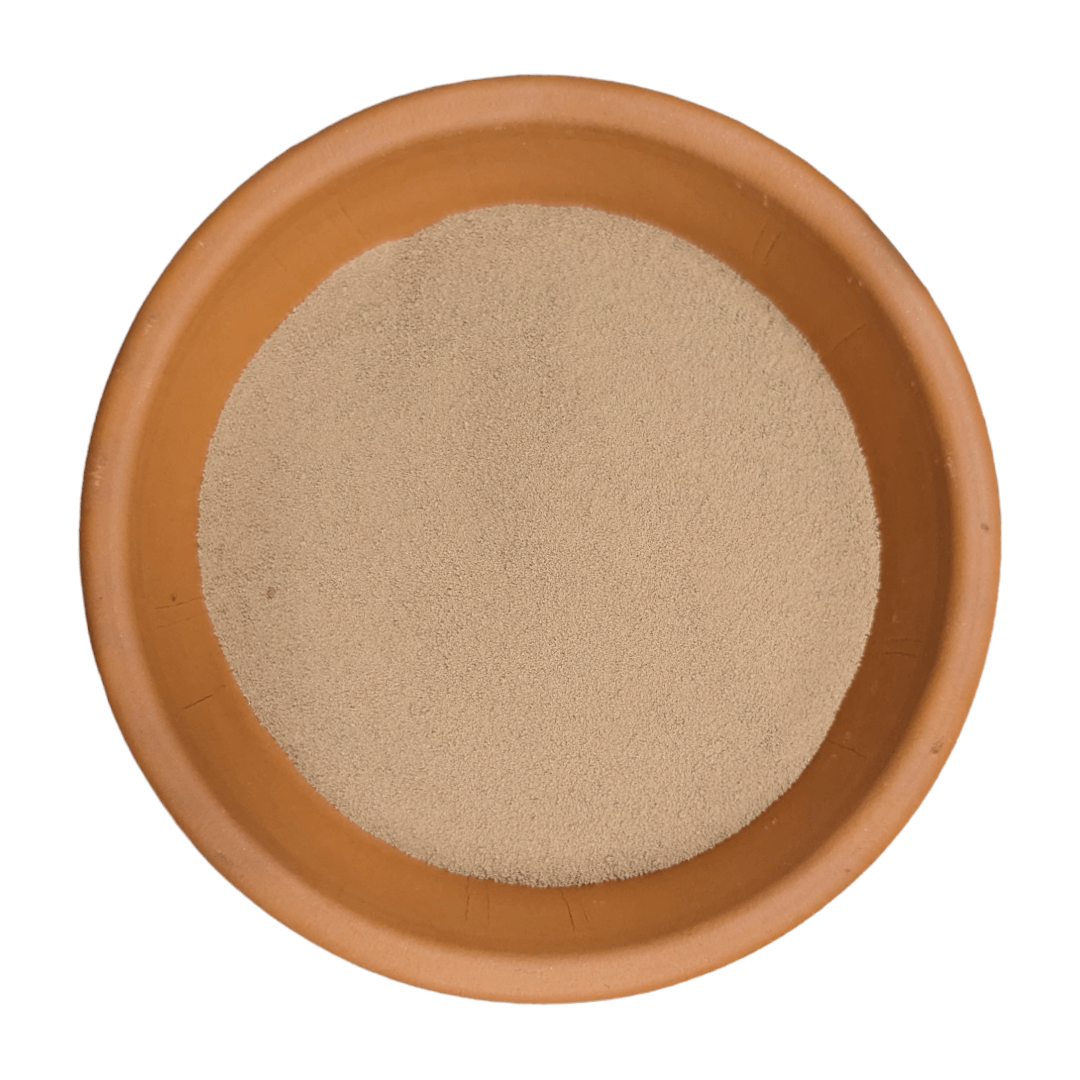Elemental sulphur is a valuable tool in gardening and agriculture due to its various applications and benefits. Here's a summary of how elemental sulphur is used to improve soil quality and plant health:
-
Soil pH Adjustment: Elemental sulphur is commonly used to lower the pH of alkaline soils. Soils with a high pH can limit the availability of essential nutrients to plants. By adding elemental sulphur, the soil's pH gradually becomes more acidic. This process is a result of sulphur oxidation, which produces sulfuric acid, leading to a decrease in soil pH.
-
Nutrient Availability: Lowering soil pH through sulphur application can increase the availability of specific essential nutrients, including iron, manganese, and zinc. This is particularly advantageous for plants that thrive in acidic soils, such as blueberries and azaleas.
-
Pest and Disease Control: Sulphur has a long history of use as a natural fungicide and miticide. When applied to plants, it can effectively control various fungal diseases like powdery mildew, rusts, and mites. However, it's crucial to use sulphur cautiously, as excessive application can potentially harm plants.
-
Source of Sulphur for Plants: Sulfur is an essential macronutrient for plants, playing a vital role in the synthesis of amino acids, proteins, and vitamins. While many soils contain sufficient sulfur, in some cases, especially in sandy soils or regions with heavy rainfall, sulfur deficiency may occur. In such situations, elemental sulfur can serve as a direct source of this essential nutrient.
-
Improved Soil Structure: Elemental sulfur can enhance soil structure, particularly in heavy clay soils. It promotes soil particle aggregation, leading to improved aeration and water movement in the soil, which benefits plant root health.
-
Enhanced Nitrogen Fixation: For leguminous plants that form symbiotic relationships with nitrogen-fixing bacteria, a slight reduction in soil pH resulting from sulfur application can enhance the process of nitrogen fixation, improving overall plant growth.
-
Reduction of Sodium in Soils: In areas with elevated sodium levels in the soil, elemental sulfur can aid in reducing sodium content. As sulfur oxidizes, it forms sulfuric acid, which can react with sodium, facilitating the leaching of sodium out of the root zone and improving soil quality.
Incorporating elemental sulfur into gardening practices can be an effective way to address soil pH issues, provide essential nutrients to plants, and manage certain pests and diseases. However, it's essential to use sulfur judiciously and follow recommended application rates to avoid any adverse effects on plants or soil.
FAQs:
What exactly is Elemental Sulphur?
Elemental Sulphur granules/powder at 800 g/kg (80% S) designed to acidify alkaline soils and unlock nutrients for acid-loving plants.
How does elemental sulphur lower soil pH?
Soil microbes oxidise sulphur → sulfuric acid forms → pH drifts down over weeks to months. It’s a biological (slow) process, not an instant chemical reaction.
How fast will I see a pH change?
Expect movement in 4–12+ weeks in warm, moist, aerated soil. Cooler temps, dry soil, and heavy clay all slow it down. Plan months, not days.
What plants is Elemental Sulphur good for?
Blueberries, azaleas, camellias, hydrangeas (for bluer blooms), rhodos, and any crop that prefers acidic soil. Also helpful where iron/manganese look “locked out” in high-pH soils.
Can I use Elemental Sulphur in pots or only in garden beds?
Both—but go lighter in pots. Mix tiny amounts through the potting mix (or top-dress very sparingly) and re-test pH. Pots react faster and are easier to overdo than garden beds.
Roughly how much should I use per application?
As a conservative, garden-friendly cap: around 100 g per m² per application. You can repeat in 6–12 weeks after testing pH. For pots, think teaspoons—not tablespoons—per 10–20 L of mix.
How many applications will I need?
Depends on your starting pH, soil texture, and target. It’s common to do 2–3 light applications over a season rather than one heavy hit.
I need a big pH drop (e.g., 7.5 → 5.5). How do I tackle that?
Do it in stages. Apply small, split doses, mix in if you can, keep soil warm and evenly moist, and re-test after each round. Trying to crash pH in one go risks plant stress.
What’s the best timing?
When soils are warm (microbes are active). Early spring through early autumn is ideal. Mid-winter? Expect almost no action.
Do I need to water it in?
Yes—lightly. You want the topsoil evenly moist, not soggy. Good aeration + moisture = faster microbial conversion.
Should I till/mix Elemental Sulphur in or just top-dress?
Incorporating into the top 5–10 cm works faster. Top-dressing still works; it just takes longer to influence the whole root zone.
Can I use Elemental Sulphur right around established plants?
Yes—apply in a doughnut around the dripline, avoid piling against the trunk/stem, and keep doses modest. Re-test before repeating.
Will Elemental Sulphur hurt worms and soil life?
Used sensibly, no. Over-applying to the point of creating very acidic, anaerobic conditions will stress biology. Slow and steady wins.
Is Elemental Sulphur the same as “wettable sulphur” fungicide?
No. Elemental sulphur can be formulated for fungicidal use, but this product is sold as a soil amendment to adjust pH. For disease control, use a product that’s specifically registered/labeled as a fungicide and follow that label.
Can I combine sulphur with other amendments?
Yes—compost, peat, pine bark fines, and acid-plant fertilisers pair well. Avoid applying sulphur at the same time as lime or dolomite; they fight each other.
What about gypsum—does that acidify like sulphur?
No. Gypsum (calcium sulfate) adds calcium/sulphate but doesn’t lower pH. If you need to acidify, elemental sulphur is the go-to.
Is aluminium sulfate a faster option?
It can act faster but brings aluminium—best avoided at high rates, especially around blueberries. Elemental sulphur is the safer long-play for edible and acid-loving crops.
Will Elemental Sulphur fix chlorosis (yellow leaves) in high-pH soils?
Often, yes—by lowering pH so iron/manganese become available. For a quick cosmetic bump while sulphur works, you can use chelated iron as a foliar or soil drench.
How do soil types change the rate?
Sands need less; clays and high-organic soils need more for the same pH shift. That’s why we push split, test-driven applications.
Does Elemental Sulphur work in very calcareous (limey) soils?
It’ll nudge pH down temporarily, but free lime can “rebound” pH over time. Expect maintenance doses or consider raised beds/containers for blueberries and other acid lovers.
Can I use Elemental Sulphur in hydro or recirculating systems?
No—this is for soil/soilless media. Use proper pH control acids designed for hydroponics.
Will Elemental Sulphur change my hydrangea flower colour?
Lowering soil/media pH increases aluminium availability, which encourages blue tones in suitable hydrangea varieties. It still takes weeks to months and may need maintenance.
Can I apply Elemental Sulphur to lawns?
Yes—same light, even rates (≈100 g/m² max per application), during active growth, and water in. Test first to confirm you actually need acidity on your turf.
Do I need a soil test, or can I just guess?
Test. Even a simple pH kit saves time and avoids overshooting. For big projects, lab tests are cheap insurance.
What if I overshoot and the soil gets too acidic?
Dust lightly with garden lime or dolomite and water in. Re-test after a couple of weeks before adding more.
Is temperature really that important?
Yep. Microbes are sluggish in cold soils. Below ~13 °C, expect minimal change.
Will heavy rain or over-irrigation cause issues?
Yes—waterlogging starves microbes of oxygen and can create rotten-egg (H₂S) conditions that harm roots. Keep it moist, not saturated, and improve drainage if needed.
Is there any odour?
The sulphur itself is near-odourless. Anaerobic, waterlogged soils can produce a rotten-egg smell—fix drainage/aeration immediately if that happens.
Is Elemental Sulphur safe around pets and kids?
Low acute toxicity, but the dust can irritate eyes/airways. Keep out of reach, apply when the area is empty, and water in. Store sealed and dry.
Any PPE needed when applying?
Common sense gear: gloves, dust mask/respirator, and eye protection—especially on windy days or when stirring into soil.
Is sulphur flammable?
The dust is. Keep away from open flames, cigarettes, and hot embers during handling.
How does the 800 g/kg strength compare to others?
It’s an 80% elemental sulphur product. Strong enough for efficient soil acidification without being finicky to handle.
How long does Elemental Sulphur last once applied?
It reacts over months and the effect can persist, but alkaline irrigation water and limy soils can drift pH back up. Expect occasional top-ups as maintenance.
Can I broadcast Elemental Sulphur, or should I spot-treat?
For bed prep: broadcast and mix in. For established plants: ring the dripline. For pots: blend through or scratch in a very thin layer, then water.
I only want a tiny tweak in pH. Any tips?
Use half-rates (or less), retest after 4–8 weeks, and stop as soon as you hit the target. It’s easier to add a bit more than to correct an overshoot.
Does Elemental Sulphur supply plant sulphur nutrition too?
Yes—elemental sulphur ultimately becomes sulphate, a plant-available nutrient. Think of that as a bonus while the main job (pH shift) happens.
Will Elemental Sulphur improve soil structure?
Indirectly—by enabling better root growth and microbial activity. The product itself doesn’t “flocculate” clay like gypsum, but healthier biology and roots help soil crumb over time.
Any “don’ts” I should know?
Don’t dump big heaps against stems. Don’t combine with lime/dolomite in the same pass. Don’t expect instant results. Don’t apply to waterlogged or frozen soil.
What’s a simple starter plan for a 10 m² blueberry bed at pH ~7?
Apply ~1 kg total (≈100 g/m²), mix into the top 5–10 cm, water, and retest after 6–8 weeks. Repeat if needed until you’re near 5.0–5.5, then switch to light maintenance doses.
How do I maintain acidity once I’m on target?
Use rainwater where possible, mulch with pine bark/needles, feed with acid-lover fertilisers, and add small sulphur top-ups a couple of times per year as testing dictates.



